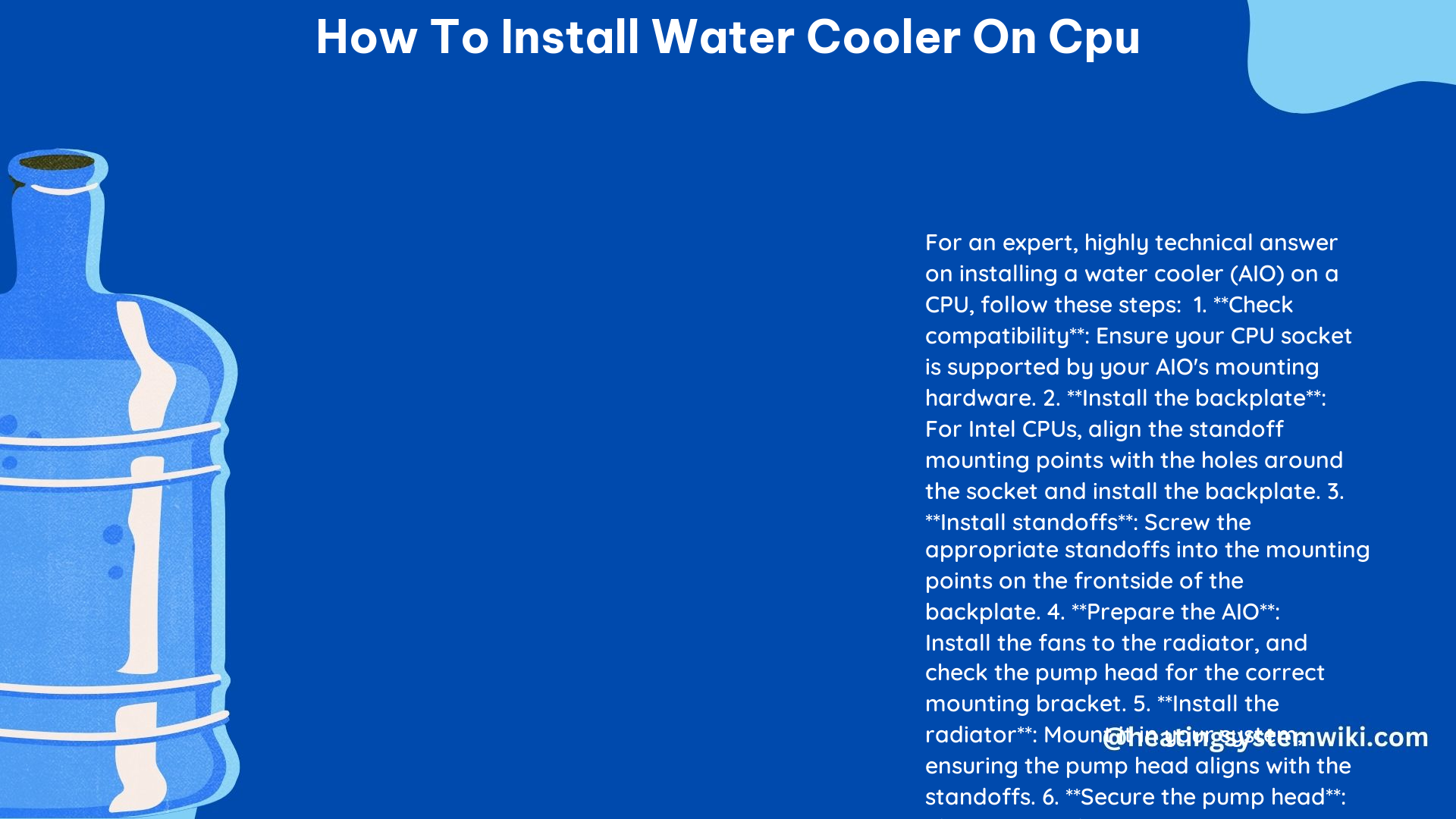Installing a water cooler on a CPU can be a complex process, but with the right tools and a step-by-step guide, you can successfully complete the task. This comprehensive guide will walk you through the entire installation process, providing detailed instructions and technical specifications to ensure a smooth and efficient setup.
Preparing the Components
Before you begin the installation, it’s crucial to ensure that you have all the necessary components. This typically includes the water cooler unit, which consists of a water block, radiator, fans, and tubing, as well as any mounting hardware or accessories provided by the manufacturer.
It’s important to carefully unpack the water cooler and inspect all the components to ensure that they are in good condition and that no parts are missing. Additionally, you should have the following tools on hand:
- Screwdrivers (Phillips and flathead)
- Thermal paste
- Isopropyl alcohol (for cleaning the CPU surface)
- Scissors or wire cutters (for adjusting tubing length if necessary)
- Cable ties (for managing the wiring)
Mounting the Radiator

The first step in the installation process is to mount the radiator. The location of the radiator will depend on the design of your computer case and the available space. Typically, the radiator is mounted at the top or front of the case, where it can effectively dissipate the heat generated by the CPU.
To mount the radiator, you will need to remove any dust filters or covers from the top or front of the case, depending on the installation location. Then, carefully position the radiator and align it with the screw holes in the case. Use the provided washers and screws to secure the radiator in place, ensuring that it is level and properly aligned.
It’s important to note that the orientation of the radiator can affect the performance of the water cooler. For optimal results, it’s recommended to mount the radiator with the tubes at the bottom, allowing for efficient circulation of the coolant.
Applying Thermal Paste
Before installing the water block, you need to apply a thin, even layer of thermal paste to the CPU. This helps to improve the thermal conductivity between the CPU and the water block, ensuring efficient heat transfer.
When applying the thermal paste, it’s important to use a high-quality, non-conductive paste and to avoid using too much. A pea-sized amount in the center of the CPU is typically sufficient. Use a clean, lint-free cloth to gently spread the paste across the entire surface of the CPU.
Installing the Water Block
The next step is to install the water block, which is the component that directly contacts the CPU and transfers the heat to the coolant. The installation process may vary depending on the type of water cooler and the motherboard socket.
For an LGA 1200 socket, you will need to install a backplate on the back of the motherboard and secure it with screws. Then, apply the thermal paste to the CPU and carefully place the water block on top, making sure to align the screw holes. Secure the water block in place using the provided screws.
If you have an AMD socket, you may need to use the motherboard’s clips or a backplate to mount the cooler’s pump. Ensure that the backplate’s corner screw holes are aligned with the corresponding holes on the motherboard around the CPU socket.
Connecting the Fans and Pump
The final step in the installation process is to connect the fans and pump to the motherboard. The fans are responsible for drawing air through the radiator, while the pump circulates the coolant through the system.
Locate the appropriate fan and pump headers on your motherboard, typically labeled as “CPU_FAN” and “PUMP_FAN” or similar. Connect the fans and pump to these headers, using a fan splitter or RGB splitter if necessary to accommodate multiple fans.
It’s important to ensure that the fans and pump are connected to the correct headers and that the cables are routed neatly to avoid any interference or obstruction.
Additional Tips and Considerations
Here are some additional tips and considerations to keep in mind when installing a water cooler on a CPU:
- Double-check for Missing Parts: Before starting the installation, carefully inspect the contents of the water cooler package to ensure that all necessary components are present.
- Follow the Manufacturer’s Instructions: Closely follow the instructions provided by the water cooler manufacturer, as the specific steps may vary depending on the model and your system configuration.
- Manage Cable Routing: Carefully route the cables for the fans and pump to ensure a clean and organized appearance, and to avoid any potential interference with other components.
- Monitor Temperatures: After the installation, monitor the CPU temperatures to ensure that the water cooler is functioning properly and providing adequate cooling.
- Seek Professional Assistance: If you encounter any issues or have questions during the installation process, don’t hesitate to consult the manual or seek help from a professional.
By following these detailed instructions and technical specifications, you can successfully install a water cooler on your CPU and enjoy the benefits of improved cooling performance and lower temperatures.
